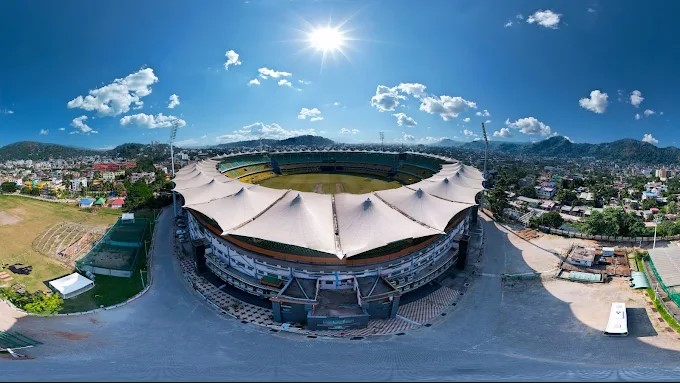Barsapara Cricket Stadium, also known as the Dr. Bhupen Hazarika Cricket Stadium, is located in Guwahati, Assam. As one of the newest international stadiums in India, it has quickly gained recognition for its modern design and facilities. Among its key features, the boundary dimensions have been a topic of interest, especially considering how crucial ground size is in shaping match strategy, scoring patterns, and bowling tactics.
Table of Contents
This article explores the boundary length of the Barsapara Stadium, how it compares to other venues, its impact on the game, and additional insights backed by match statistics and layout configurations.
Stadium Overview
| Feature | Detail |
|---|---|
| Stadium Name | Dr. Bhupen Hazarika Cricket Stadium |
| Location | Guwahati, Assam, India |
| Establishment | 2012 (inaugurated for international use in 2017) |
| Capacity | Approx. 40,000 spectators |
| Primary Use | International & Domestic Cricket |
| Owner | Assam Cricket Association (ACA) |
Boundary Dimensions
Boundary lengths in cricket are not fixed, and they can vary depending on how the ground staff lays the boundary ropes. However, there are general dimensions that Barsapara follows based on ICC regulations and ground constraints.
Typical Boundary Measurements
| Boundary Type | Length (in meters) | Notes |
|---|---|---|
| Straight | 70-75 meters | Generally longer than square boundaries |
| Square (off/on) | 63-68 meters | Slightly shorter, suitable for aggressive stroke play |
| Behind Square | 60-65 meters | Often targeted in T20s |
| Third Man/Fine Leg | 58-62 meters | Among the shortest zones of the ground |
These measurements can vary by 2-5 meters depending on temporary adjustments for advertising boards, camera placements, and safety buffer zones.
ICC Guidelines on Boundary Size
The ICC mandates a minimum boundary distance of 59.43 meters (65 yards) from the center of the pitch, wherever possible. Barsapara comfortably meets this requirement with boundaries ranging between 60 to 75 meters, ensuring that the venue is fit for international matches in all formats — T20Is, ODIs, and Tests (if hosted in future).
Comparison with Other Indian Stadiums
To better understand how Barsapara’s boundary length ranks, here’s a comparison with some prominent Indian stadiums:
| Stadium | Straight Boundary (m) | Square Boundary (m) |
|---|---|---|
| Barsapara (Guwahati) | 70-75 | 63-68 |
| Wankhede (Mumbai) | 65-70 | 60-65 |
| Eden Gardens (Kolkata) | 76-80 | 66-70 |
| M. Chinnaswamy (Bangalore) | 65-70 | 59-63 |
| Narendra Modi Stadium (Ahmedabad) | 75-80 | 68-72 |
Barsapara’s boundaries are moderately sized — larger than Wankhede and Chinnaswamy but slightly smaller than Eden Gardens or Ahmedabad.
Impact on Playing Style
1. Batting Strategy
Medium boundary lengths at Barsapara encourage a balanced approach. While six-hitting is certainly achievable, especially for modern power-hitters, players also benefit from timing and placement to exploit gaps.
Notable Batting Records at Barsapara:
- India scored 237/3 vs South Africa in 2022 (T20I), showing that big scores are possible.
- Average T20I score at this ground: 170+
2. Bowling Dynamics
Bowlers, particularly spinners and medium pacers, benefit from larger straight boundaries. Field placements can be adjusted to force batters to hit square, where boundaries are shorter but can be better defended.
Effective Bowling Lengths:
- Spinners often bowl wider outside off to encourage aerial drives to the long straight boundaries.
- Pacers rely on back-of-length deliveries to cramp batters from targeting square zones.
Wind & Altitude Factors
Barsapara’s location in a relatively humid and low-altitude region of Assam means the ball doesn’t travel as far in the air as it does at high-altitude venues like Dharamsala. This natural factor further adds to the practical “length” of the boundaries, making six-hitting slightly more effortful.
Stadium Shape & Boundary Curvature
Unlike some grounds that are oval or circular, Barsapara has a semi-elliptical layout, which means:
- Straight boundaries are the longest.
- Square boundaries taper slightly, especially toward fine leg and third man.
- The angle of elevation from the pitch to stands can affect visuals and player judgment during high catches or lofted shots.
Simplified Layout View
Straight Boundary (~75m)
_________
/ \
Square (~68m)/ \ Square (~68m)
| Pitch |
Square (~63m)\ / Square (~63m)
\_________/
Straight Boundary (~70m)
Influence on Match Outcomes
T20 Matches
In T20s, a boundary of 63-68 meters is considered balanced — it allows attacking cricket but penalizes mishits. Matches at Barsapara often see competitive totals in the 160–190 range, with successful chases common due to true pitch and fast outfield.
ODIs
ODI matches may see higher scores (280-320 runs), as batters adapt better to the dimensions over a longer format. The moderate boundary size helps keep bowlers in the game, especially during middle overs.
Spectator Experience
From the stands, the boundary size also affects the fan experience:
- Close fielding and catches are often within 10-15 meters of the boundary ropes, giving fans a thrilling view.
- Sixes landing in the stands are frequent enough to keep excitement high, but not so frequent that they reduce the novelty.
The Barsapara Cricket Stadium offers a balanced playing field in terms of boundary length. With straight boundaries between 70-75 meters and square ones around 63-68 meters, it stands as a moderate-sized venue that caters to both bowlers and batters. This equilibrium makes it an ideal setting for competitive cricket, whether in T20Is or ODIs.
As the stadium continues to host more international fixtures, its boundary dimensions will remain a central feature shaping match dynamics. And for fans in Assam, the thrill of international cricket — amplified by soaring sixes and tactical bowling — is just getting started.

